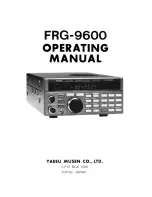
Geophysical Survey Systems, Inc.
SIR® 20
Manual
MN92-078 Rev F
33
Gain should never decrease with depth. Each successive gain point should be greater than or equal to the
previous. Be careful not to apply too much gain. This will lead to a phenomenon known as ‘clipping’.
Clipping will limit the data and will cause you to lose valuable information and make it much more
difficult to identify targets in the data. In addition, RADAN functions such as vertical and horizontal
filtering, FFT filtering, Spectrum transformation and Hilbert envelope processing will not operate
correctly on the data. If you prefer to leave the gain setting up to the SIR 20, make sure that Auto Gain
Servo is enabled.
Figure 32: Example of clipped versus acceptable data.
Filters and Stacking
The next three buttons control the vertical and horizontal filters, background removal and vertical (time)
stacking filters. These are useful for reducing high and low frequency noise in the data. The background
removal filter is extremely useful for removing antenna coupling effects (e.g., antenna ring-down) that
generate horizontal noise bands in the data. The static stacking filter is useful for removing random high
and low frequency noise in the data, but at the expense of a slower system recording speed.
Referring to the icons above from left to right, the filters available during data collection are the IIR
(Infinite Impulse Response) filter, FIR (Finite Impulse Response) filter and Static Stacking and
Background Removal filter respectively. A detailed description of these filters is beyond the scope of this
manual.
If you are interested in learning more about these filters and their effects, we would refer your attention to
a text on digital signal processing. Many of these values are antenna-specific and are set automatically for
the antenna that you chose in Step
6
. If you are using an antenna other than one listed in the configuration
presets, you should alter the correct filter setting for the antenna being used. Consult your antenna
documentation for the antenna filter default settings.
There is also a listing of common antennas and their default settings at the back of this manual.
Be sure to
pay special attention to the IIR filter settings and make sure that they are correct for the antenna
frequency you are using
. If you selected an antenna in the Config Name box in Step
7
, the correct settings
have already been input into the system configuration. GSSI recommends that inexperienced users accept
the default filter settings.
Any changes you make to the collection parameters are automatically stored in the macro file. After you
are satisfied with the collection parameters, click the green arrow to begin collection. You will then be
guided through your collection by the onscreen prompts.
Summary of Contents for SIR 20
Page 1: ......
Page 4: ......
Page 6: ......
Page 12: ...Geophysical Survey Systems Inc SIR 20 Manual MN92 078 Rev F 6 ...
Page 56: ...Geophysical Survey Systems Inc SIR 20 Manual MN92 078 Rev F 50 ...
Page 88: ...Geophysical Survey Systems Inc SIR 20 Manual MN92 078 Rev F 82 ...
Page 96: ...Geophysical Survey Systems Inc SIR 20 Manual MN92 078 Rev F 90 ...
















































